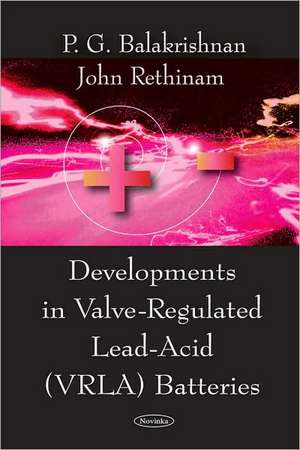Developments in Valve-Regulated Lead-Acid (VRLA) Batteries
Autor P. G. Balakrishnan, John Rethinamen Limba Engleză Paperback – 3 dec 2008
Preț: 254.69 lei
Preț vechi: 340.08 lei
-25% Nou
Puncte Express: 382
Preț estimativ în valută:
48.74€ • 50.99$ • 40.48£
48.74€ • 50.99$ • 40.48£
Carte indisponibilă temporar
Doresc să fiu notificat când acest titlu va fi disponibil:
Se trimite...
Preluare comenzi: 021 569.72.76
Specificații
ISBN-13: 9781604562699
ISBN-10: 1604562692
Pagini: 110
Ilustrații: b/w illus
Dimensiuni: 155 x 227 x 9 mm
Greutate: 0.22 kg
Editura: Nova Science Publishers Inc
ISBN-10: 1604562692
Pagini: 110
Ilustrații: b/w illus
Dimensiuni: 155 x 227 x 9 mm
Greutate: 0.22 kg
Editura: Nova Science Publishers Inc
Cuprins
Preface; The History of Lead-Acid Battery; The Development of Valve-Regulated Lead-Acid Battery; Criteria for the Successful Operation of "Oxygen Cycle" in VRLAB; Grids and Alloys for VR Batteries; Casting of Grids; Paste Mixing and Pasting Operations; Curing; Absorptive Glass Mat Separator (AGM); Formation; Cadmium Voltage Readings; Assembly of VR Batteries; Containers and Covers; Pressure Vents (Safety Valves); Assembly of Gelled VR Batteries; Assembly of AGM Batteries; Filling of VR Batteries with Electrolyte; Filling of AGM Batteries with Electrolyte; Filling of Gelled VR Batteries with Electrolyte; Conditioning Cycles; Advanced Lead-Acid Battery Consortium; Element Compression; Fast Charge; New Generation Automotive Batteries; Operational Experience; Failures of VRLAB-Causes and Remedial Measures; Temperature/Thermal Runaway/Dry Out; Battery Monitoring; Catalyst; Results of Experiments with Catalysts; Failure of Negative Half-Block; Premature Capacity Loss [220-229]; Conclusion; Index.
